
18 minute read
How It All Started
Established 1895: how Autocar led a transport revolution
Leading motoring historian David Burgess-Wise recounts how, 125 years ago, a young Englishman was inspired to start a magazine about horseless carriages – and how it became a prime part of a transformative, titanic new global industry
Advertisement
magine, if you can, a world without
Icars, a world where road traffic moves at the speed of the pedestrian, the pedal cycle and the horse-drawn cart. It’s not a silent world: the noises are just different – the shouting of street vendors, the clatter of hooves and iron-shod tyres on cobbled roadways, the jingling of bicycle bells and the whistle of steam engines. But it’s an alien world, where the streets literally run with pollution from the millions of horses on which the economy depends, where long-distance travel is governed by the tyranny of the train timetable, where a town only 10 miles from the nearest railway station can seem as remote as though it were in the middle of nowhere. It’s a world that has changed only gradually over the past 100 years, with the coming of the railway the biggest transport revolution since the Middle Ages. There are, indeed, road-going steam traction engines, but they’re big, unwieldy brutes weighing several tons whose iron wheels break up the road surface. Consequently, they’re restricted to walking speed by a harsh law that compels every “self-propelled vehicle” on the roads to be preceded by a man on foot, usually carrying a red flag. This is the United Kingdom in 1895, an island nation whose empire encircles the world, the hub of the Industrial Revolution.
But it’s a decade behind its Continental rivals,
France and Germany, in adopting the motor car, with not a single native manufacturer and maybe only six cars in the entire country.
Every time they venture onto the streets, their drivers risk falling foul of the law, for parliament refuses to recognise the light and handy car as anything different from a five-ton traction engine. Therefore, says the law, every car must have a driver, an engineer and a man walking in front to warn of its approach.
Then, one afternoon late in the year, an unfamiliar noise is heard in the streets of Coventry, centre of the cycle industry and home of the successful printing company Iliffe, Sons and Sturmey, publishers of the country’s leading cycling magazine, The Cyclist. The staff all rush to the door to see what it is: “A motor car!”
At the tiller of the strange machine is Harry Lawson, a pompous little man with protuberant eyes. A famous – even notorious – figure in the Coventry cycle industry, he has made a huge fortune out of launching over-capitalised


The automotive industry expanded rapidly in the 1890s
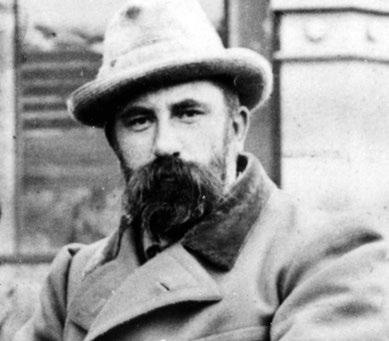
Henry Sturmey founded Autocar in 1895 and led it to 1901
❝ When Britain’s first car manufacturing firm was created, Autocar’s editor was on the board ❞
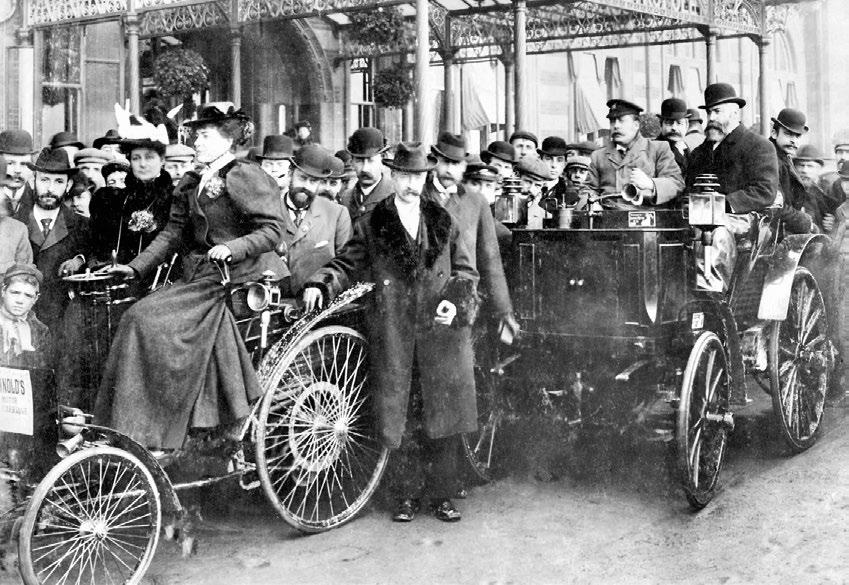
companies that, after paying spectacular dividends for a couple of years, usually collapse in financial chaos. He often collaborates with the most notorious company promoter of the day, Terah Hooley. When Hooley bought the Dunlop Pneumatic Tyre Company for £3 million and floated it as a new concern for £5 million, Lawson made a reputed £500,000 out of the deal.
Lawson has called to see the editor of The Cyclist, a solemn-looking former schoolteacher named Henry Sturmey, who founded the magazine – originally known as The Bicyclists’ Independent Handbook – in 1879 at the age of 22 and later sold the title to the enterprising Iliffe company, which prints the lithographic transfers for the cycle frames of Coventry.
Young William Iliffe, anxious to launch a new magazine to catch the profitable weekend market, has so far been unable to fix on a suitable subject. The sight of the motor car sets him thinking: “Mr Sturmey,” he asks his partner as soon as Lawson has departed, “do you believe those things will ever come to anything and be used on the roads?” “I do, Mr Iliffe.” “Have you enough material for a journal about them?” “I have, Mr Iliffe.” “Then we will bring out a paper about them… tomorrow!”
But what should the name of the new publication be? Sturmey runs through the possibilities, for cars are so new no one is quite sure what to call them: “Horseless carriage, automobile carriage, automatic carriage… autocar!” Just in case there’s any doubt, Sturmey subtitles the new magazine: “A journal published in the interests of the mechanically propelled road carriage”. Deadlines have rarely been shorter in the long history of the world’s oldest motor magazine, yet on Saturday 2 November 1895, the first
In 1895, nobody could have guessed that the Michigan city of Detroit would one day be nicknamed Motown, for not a single car had yet been seen there. It would be some six months before Henry Ford’s experimental tricycle made its first run through the sleeping city on a quiet June night (maybe a sensible precaution, for he had forgotten to fit his little car with brakes!) as the herald of a new and colossal industry.
In 1896, the Duryea brothers would start limited production of their “marvellous American autocar”, but even then cars were regarded more as a circus turn than as a serious mode of transport. Autocar’s description of this car could be claimed as the first of its world-famous road tests: “It is neat and compact, steers as easily as a bicycle, starts and stops by the manipulation of the steering lever, so that the whole control of the vehicle is in one hand and within reach of either passenger; it runs forward or backward at will, and can be handled with a nicety not obtainable in a horse.”
Handling considerations were very different back in those days: “A further element of safety is found in the fact that it will run over a goodsized rock with either wheel ‘hands off’. This ensures that the steering is not twitched out of one’s hand accidentally and the carriage upset on its passengers, as is both possible and probable with many steerings hitherto used.”
Motoring was so young when Autocar started that there wasn’t even an accepted technical language: describing the Peugeot car owned by British motoring pioneer Sir David Salomons, who had just organised England’s first motor show (reported, of course, in Autocar’s first issue), the magazine’s reporter referred to “the starting and stopping lever”, the “speed variation lever” and a “foot lever for the purpose of throwing the engine out of gear”.
In fact, with the clear technical descriptions of new cars that quickly became a regular feature of the magazine, Autocar helped to create the language of motoring.
It also helped to create Britain’s car industry, for when Britain’s first motor manufacturing company, Daimler, was created in January 1896, Sturmey was one of the board members. Nowadays that would be construed as a conflict of interest, but back then there were so few people in Britain who knew anything at all about cars that Sturmey’s presence on the à

HAPPY BIRTHDAY AUTOCAR Jim Farley
Congratulations to Autocar and everyone who has ever worked at the bible of the European car scene. One of my happiest reads since I was a kid and then when I worked my way through school at a shop run by F1 champion Phil Hill. I still get edgy as I get ready to read the latest on what you think of a car I’ve worked on. One of my best car memories was viewing your archive, especially finding pictures of the Vanderbilt race cars in the US before the turn of the century. Your archive is an industry treasure. Keep your engines revving!
issue of The Autocar, containing a mere 12 pages of editorial, is on the news-stands.
For its first year, Autocar really was a magazine for a persecuted minority, for it wasn’t until 14 November 1896 that the government changed the law to allow motorists “the freedom of the road”. It was, admittedly, a qualified freedom, for there was still a nationwide speed limit, strictly policed, of 12mph, but the infamous ‘red flag man’ was gone.
To celebrate this ‘emancipation day’, Lawson’s Motor-Car Club organised a tour from London to Brighton – still celebrated by the annual London to Brighton Run for pre-1905 cars organised by the Royal Automobile Club – and The Autocar brought out a special ‘red-letter day’ issue, printed in red ink. The pent-up demand for cars was shown by the thousands of copies of the issue that were sold.
Reports vary, but it seems that around 33 cars started for Brighton and 22 got there in time for the celebration dinner. But many years later, Autocar could reveal that several had managed to cover the 50 miles between London and Brighton only because they had been taken down by train!
A DRIVING FORCE
Right from the start, Autocar reported on the international scene: that inaugural issue carried an article on America’s first practical car, the Duryea. The car was to transform America and become an indispensable feature of everyday life – yet at that point, the US was a long way behind Europe in terms of development.
Autocar contributed to the success of the Ford Model T



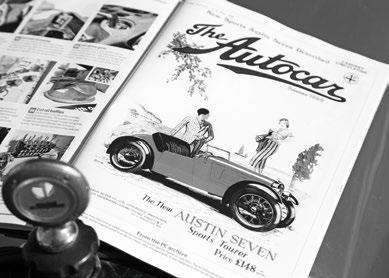
1907 Rolls-Royce stunned our tester with its refinement First road test subject proper was a 1928 Austin Seven
ßDaimler board represented a steadying influence in the running of the company, particularly since the man behind Daimler was that get-rich-quick company-promoter Lawson. By the time that Sturmey resigned in 1899, having served a term as chairman, Daimler was firmly established as Britain’s leading car manufacturer.
TRIED AND TESTED
From its earliest days, Autocar has given its readers practical reports on literally thousands of cars. Since it began numbering road tests in 1928, nearly 5500 have been published. However, its staff was testing cars from the very beginning – although Autocar’s reporters didn’t always take the wheel themselves in those days.
Once the brave days of the pioneers had ended, around 1900, and the number of cars on the roads increased rapidly, a large proportion of European motorists kept paid chauffeurs. Consequently, many of Autocar’s early tests were written from the point of view of the owner, rather than the driver.
Indeed, it was such a test that brought Sturmey’s days in charge of Autocar to an end in October 1900, when the experimental Dawson car in which he was riding (its designer was a successful marine artist who had designed a petrol engine with an unusual double-diameter piston giving a degree of forced induction) crashed after a tyre left its rim. Sturmey’s arm was broken, and he was so badly shaken by the crash that he spent months off work and eventually retired in 1901 on medical grounds.
It has to be said that many of those early reports were road impressions, rather than true road tests, although on at least one occasion Autocar’s verdict achieved immortality. That was early in 1907, when an Autocar staffer rode on the new 40/50hp RollsRoyce Silver Ghost and reported: “At whatever speed this car is being driven on its direct third [speed] there is no engine as far as sensation goes, nor are one’s auditory nerves troubled driving or standing by a fuller sound than emanates from an eight-day clock.” Advertising man David Ogilvy may have said it more succinctly 50 years later when he wrote “At 60mph the loudest noise in the new Rolls-Royce comes from the electric clock,” but The Autocar said it first.
Around 1910, new, more affordable cars created an increasing number of owner-drivers, and a new sort of ‘hands-on’ road test began to appear in the pages of The Autocar. One of the best was written in 1910 by Basil H Davies, a frequent contributor. He borrowed an early Ford Model T for his official duties as a judge in a six days’ motorcycle trial in Scotland and, when he returned home 1700 miles later, was so impressed with the way the Ford – at £220 one of the cheapest four-seat cars on the
British market – had performed that he wrote one of Autocar’s first extended driving tests. The Ford – which had only two speeds in its pedal-operated gearbox – coped with flooded roads, steep mountain passes and deeply rutted roads far better than the pricier cars following the trial, and although Davies’ language may now be old-fashioned, there’s no doubting the sincerity of his verdict: “Its speed and power and silence, its reliability, economy and stalwart top gear climbing deeply impressed us; and, since no car could possibly undergo a rougher handling than we gave this one over the lofty precipices and moorland tracks of the North, there is every presumption that the car should wear excellently in ordinary service.”
No doubt Davies’ enthusiastic report was one of the factors that boosted sales to the extent that the first Ford factory outside of America was opened in England. That was one of the earliest examples of Autocar’s powers of judgement, for the Model T would change the world to such an extent that it was in 1999 named by an international jury as The Car of the Century.
Another road test that made history appeared in January 1920. During the Great War, Autocar staffer Sammy Davis had been an inspector for the rapidly expanding Royal Naval Air Service and had met a brilliant designer named WO Bentley, whose BR1 and BR2 rotary engines powered many of Britain’s most famous warplanes.
Bentley had a dream of producing a fast sporting car and, after peace came in November 1918, began work on a prototype. Naturally, the first journalist to be offered a drive on the car was Davis, and the two-page test he wrote of the 3.0-litre Bentley has become a classic of motoring literature. “Although frowned upon by the authorities, limited by law and penalised when discovered, speed is the greatest attribute of a car, and from the car alone is it possible to realise to the full that peculiar feeling of greatness, soaring almost to poetic heights, consequent upon high-speed travelling…”
Davis’s test established the Bentley marque as the outstanding British sports car maker of the 1920s, although, later lamented WO, whose young company lacked the necessary capital to go straight into quantity production: “How I wished we had had the cars we could have sold a dozen times over as a result of that piece of publicity!”
Incidentally, that famous road test wasn’t Autocar’s only contribution to the creation of the Bentley marque, for the magazine’s brilliant staff artist F Gordon Crosby had designed the famous winged-B badge that still adorns Bentley cars.
By the early 1920s, Autocar’s road tests began to take on a more organised feel. A standard route was established, taking in a variety of town and country roads to the south-west of London, where Autocar now had its head office, and using the Brooklands circuit as its halfway point. Since there was still a 20mph blanket speed limit on the roads, Brooklands gave the opportunity to legally run

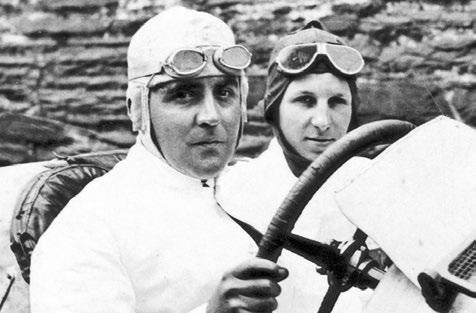
Carlos Tavares HAPPY BIRTHDAY AUTOCAR ❝ Autocar received I congratulate Autocar for its amazing 125 years in production. It has always been a reference details on the new authority on all things motoring, and I warmly applaud the team for their continued success. Model A before even Ford dealers, who had already taken 125,000 customer orders
Technology has changed greatly and rapidly since 1895 ❞
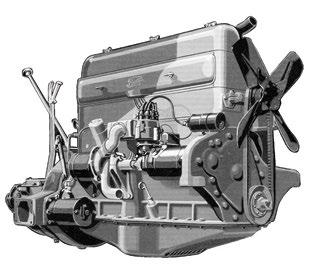

cars at top speed. And since it was conceived also as a test facility for the industry, it had a test hill on which the performance of cars could be compared.
Now Autocar’s road tests began to incorporate fuel consumption figures, based on a standard half-gallon tank, and to comment on ride and handling – although it wasn’t always easy to give figures for acceleration or cornering speeds, because a speedometer wasn’t yet mandated.
Something needed to be done to give the road tests greater authority, and a remarkable quartet of Autocar journalists – Sammy Davis, Montague Tombs, HS Linfield and Geoffrey Smith – devised a more scientific method of comparing the performance of the many and various cars on the market. Figures for braking, acceleration and fuel consumption were now given in a standard format and the dimensions of cars could be compared by the use of a standard ‘big car’ (actually a RollsRoyce Phantom) shown as a phantom image on a squared grid behind a side view of the test car.
The first of these new-format tests appeared on 13 April 1928, and appropriately it was another of the great British cars, the Austin Seven, that was its subject. For the record, it hit a top speed of 47mph, could stop in 14.6m from a speed of 25mph and managed fuel economy of 42.4mpg.
Improvements to the testing regime were steady – the phantom “big car” was replaced by carefully measured diagrams giving the internal dimensions of the test car – although sometimes there was a feeling that the tests’ well-mannered language concealed the odd moment of anxiety. “Brake power is good... though probably to obtain the best stopping figure from 30mph adjustment of the brakes would have been well,” ran a 1933 test of a Buick Straight Eight. One wonders what the tester might have hit…
To meet the increasing demand from its readers for ever more information, Autocar’s test programme became increasingly demanding. By the end of the 1960s, each car was driven at least 1000 miles during the course of a road test and sampled by six journalists, one of whom was assigned overall responsibility for the writing.
Most of the test involved normal motoring, but one day was dedicated to performance testing at MIRA. Of course, this has all been done electronically since the 1980s, and nowadays Autocar testers tend to use the modern Millbrook test track in Bedfordshire, although for testing the most potent machinery, they still visit MIRA. FIRST WITH THE NEWS

having taken 125,000 orders from keen customers. No official photographs of the car were available until 1 December, yet the following day Autocar readers opened their magazines to see a picture of the new car, obviously a pre-production prototype. It was a massive scoop, but how had Autocar, 3000 miles away from Detroit, achieved it? Only the editorial staff knew, and they weren’t telling… In 1958, few people in Europe had even heard of Japanese cars, let alone seen one. Yet Autocar’s Ronald Barker was far-sighted enough to fly to Tokyo to investigate the Japanese motor industry. He visited the factories and met the top executives of the major Japanese companies and produced a comprehensive review of the industry’s products. The following year, Autocar again beat its rivals to a coming trend when, five days before the Austin Mini was announced, Barker and a colleague picked up a prototype and prepared it for a marathon drive around the Mediterranean. A fine tribute to Autocar’s editorial skills was paid more than half a century ago, when the magazine was a mere youngster of 50, by Sir William Lyons, founder of the company that became Jaguar. He wrote: “For as long as I can remember, The Autocar has recorded motoring history for all who regard a car as something more than a means of transport. It has done so in a manner which inspires the At home and abroad, Autocar has always enjoyed enthusiast’s imagination and has contributed the confidence of the industry on which it reports, largely to the progress of motoring.” enabling it to be first with inside news and obtain And Lyons’ description of the magazine’s exclusive interviews from the people at the top, as editorial policy – “sound in views and fearless well as to uncover scoops on forthcoming models. in voicing them, accurate in technical articles
As early as that historic ‘red-letter day’ issue and statements” – was as true then as it is now. L in November 1896, Autocar published the first of literally thousands of scoop pictures – “the first British-built Daimler Autocar… from a rough hurried sketch made by our artist” – and this is another tradition that continues.
In 1927, the most eagerly awaited news in the world of motoring was what sort of car Ford was going to introduce as a replacement for his muchloved but obsolescent Model T, “the car that put the world on wheels”. Just what form its successor was going to take was a closely guarded secret. The official announcement was scheduled for 2 December, yet on 18 November Autocar was the first European periodical to publish details of the new Model A. At that time, not even Ford dealers had been told anything about the new car, despite MIRA proved an excellent road-testing site for Autocar











